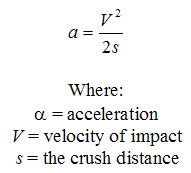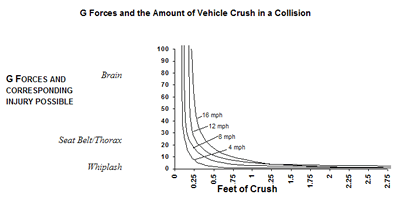One of the most frustrating types of auto accident to work with is that with little or no vehicle damage. A current report helps us understand how these collisions can result in injury.
“A common misconception formulated is that the amount of vehicle crash damage due to a collision offers a direct correlation to the degree of occupant injury. This paper explores this concept and explains why it is false reasoning…[and will] show how minor vehicle damage can relate or even be the major contributing factor to occupant injury.”
The key to understanding this concept is to recognize that the acceleration that a car experiences is inversely related to how long the car moves before it comes to a stop—or the crush distance in a collision. This is mathematically expressed as:

Let’s examine two different situations to illustrate this concept. In the first situation, we have a car that hits a solid brick wall at 10 mph (4.46 meters/sec) and crushes the front of the car 5 inches (.127 meters). In the second scenario, let’s keep the speed at 10 mph, but because of a different car design, the crush in this instance is only 2 inches (.0508 meters).
In the first example a is found to be 78.3 m/sec2 (4.46 x 4.46/2 x .127), or 8 Gs of force.
In the second example a is found to be 196 m/sec2 (4.46 x 4.46/2 x .0508), or 20 Gs of force.
Thus, a collision with the same velocity, but with a crush amount smaller by 2.5 times will have a resulting G force 2.5 times larger.
The author sums up this relationship as it relates to whiplash-type injuries:
“…on a vehicle with a chassis, no serious visual deformation may occur even though it is subjected to relatively high speeds of impact. Classically, we see this in the case of pickup trucks or all-terrain vehicles that are traditionally fitted with a solid bumper-to-bumper chassis. Many of these types of vehicles are subjected to relatively severe impacts with little or no resulting damage to their bodies and bumpers. The classic whiplash injury associated with a great deal of litigation is most likely founded on the reasoning that if there was little or no vehicle damage, no injury can result. Motor vehicle bodies or bumper-to-bumper chassis offer little or no crushing effect on arresting obstacles when impacted; thus, relatively high G forces can be experienced by occupants when rear-ended, resulting in whiplash injury. The use of stiff motor vehicle bodies and chassis will also produce a spiked G force loading to occupants, even if little damage occurs to vehicle body or chassis.”
The graph below shows the relationship between crush distance and G forces, and as we can see from this chart, vehicles that do not crush can experience very large accelerations at low speeds.

Engineering test collisions consistently show that the peak vehicle G forces in a collision are approximately twice as high as the average G forces, and that peak occupant G forces are about twice as large as peak vehicle forces. Thus, an occupant in a low speed collision with no damage to the vehicle may be at a significantly higher risk of injury than an occupant in a collision with a damaged vehicle. (For a more detailed discussion of this topic, please see our book Low Velocity Whiplash Biomechanics, available at (800) 295-3346.)
Robbins MC. Lack of relationship between vehicle damage and occupant injury. SAE 970494.